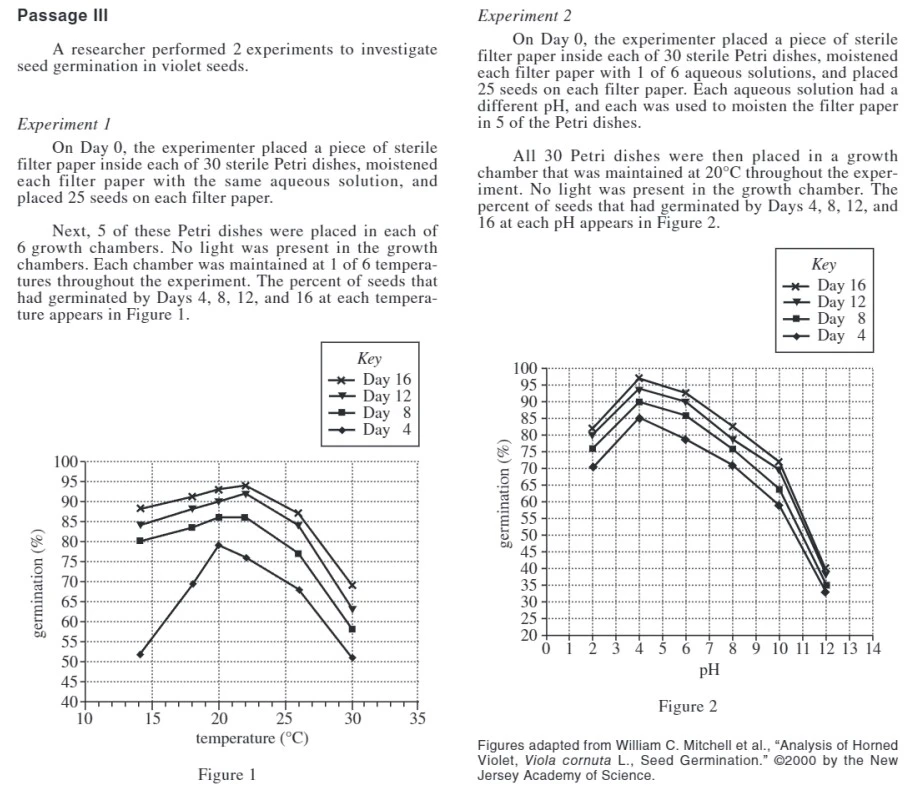Section: Science 0 Likes
Passage III - A researcher performed 2 experiments to investigate seed (September 2023 - G01)

Questions from Passage III
15) In which of the following ways did the experimental procedures used in Experiments 1 and 2 differ?
A. More seeds were used in Experiment 1.B.Fewer seeds were used in Experiment 1.
C. More temperatures were used in Experiment 1.
D. Fewer temperatures were used in Experiment 1.
16) In Experiment 2, as pH increased from 2 to 12, percent germination:
F. decreased only.
G. increased only.
H. decreased, then increased.
J. increased, then decreased.
17) Based on the results of Experiments 1 and 2, violetseeds exposed to which of the following sets of condi-tions would most likely have the highest percent ger-mination after 8 days of exposure?
A. A 16°C growth chamber and filter paper moistened with a solution with a pH of 4
B. A 16°C growth chamber and filter paper moistened with a solution with a pH of 8
C. A 21°C growth chamber and filter paper moistened with a solution with a pH of 4
D. A 21°C growth chamber and filter paper moistened with a solution with a pH of 8
18) If the seeds that were maintained at 18°C in Experi-ment 1 had been examined on Day 10, the percent ger-mination would most likely have been closest to which of the following?
F. 80%
G. 85%
H. 90%
J. 95%
19) Suppose one Petri dish in Experiment 1 had beenmaintained at 33°C. On Day 8, percent germination would most likely have been closest to which of the following values?
A. 50%
B. 60%
C. 70%
D. 80%
20) The pH of the aqueous solution used in Experiment 1was equal to the pH of 1 of the 6 aqueous solutionsused in Experiment 2. Based on this information and the results of Experiments 1 and 2, what was the pH ofthe aqueous solution used in Experiment 1?
F. 4
G. 6
H. 10
J. 12
21) A student concluded that on Day 16 of Experiment 2the seeds exposed to the most acidic solution had thelowest percent germination. Do the results support thisconclusion?
A. Yes; on Day 16, the lowest percent germination was observed in the seeds exposed to pH 2.
B. Yes; on Day 16, the lowest percent germination was observed in the seeds exposed to pH 12.
C. No; on Day 16, the lowest percent germination was observed in the seeds exposed to pH 2.
D. No; on Day 16, the lowest percent germination was observed in the seeds exposed to pH 12.
Solution
Correct answer:
15 - C
16 - J
17 - C
18 - G
19 - A
20 - G
21 - D
15 - In Experiment 1, six temperatures were used (16, 18, 21, 24, 27, and 30°C), whereas in Experiment 2, only one temperature (20°C) was used.
16 - Looking at Figure 2, you can see that the percent germination increased from a pH of 2 to a pH of 6, then decreased from a pH of 6 to 12.
17 - Experiment 1 (Figure 1) shows that at 8 days, the highest germination rate was around 70% at 21°C. Experiment 2 (Figure 2) shows that a pH of 4 solution yielded the highest germination rate at around 80% after 8 days.
18 - Looking at Figure 1, you can see that the germination rate for seeds at 18°C is around 80% on Day 8 and around 90% on Day 12. Since the rate of germination is likely increasing linearly between these days, it's reasonable to estimate that on Day 10, the germination rate would be closest to 85%.
19 - While there isn't data for 33°C in Figure 1, we can see a trend of decreasing germination rate with increasing temperature beyond 30°C. Given that the germination rate is 70% at 30°C on Day 8, it's reasonable to estimate that the rate would be lower than 70% and likely closer to 50% at 33°C.
20 - Looking at Figure 1, we can see that the highest germination rate in Experiment 1 was around 70%, which occurred at 21°C. Experiment 2 (Figure 2) shows that a pH of 6 solution yielded the highest germination rate at around 70%. Therefore, it's likely that the pH of the aqueous solution used in Experiment 1 was 6.
21 - Figure 2 shows that the germination rate for a pH of 12 is the lowest overall on Day 16. Therefore, the student's conclusion is supported by the results.
Exam Edition: September 2023 - G01
Exam Year: 2023
Related topics: Plant Physiology, Experimental Design and Data Analysis, Statistics, Critical Thinking